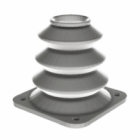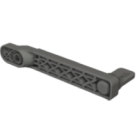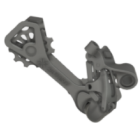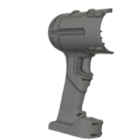3D printing overhangs
Overhangs in 3D printing refer to parts of a model that extend outward without direct support beneath them. Since most additive processes build objects layer by layer, gravity plays a major role in determining what geometries are printable — and what might sag, curl, or fail mid-print. Mastering how to design and print overhangs is essential for both structural integrity and surface quality.
Let’s take a closer look at how to 3D print overhangs properly and what to do when things go wrong.
How much overhang can a 3D printer handle?
The exact angle depends on the printer, material, and cooling, but in general, FDM printers can handle overhangs up to 45° from the vertical axis without support. Beyond this, gravity starts to affect the quality of the layers, leading to drooping or incomplete extrusion.
Resin-based printers (SLA, DLP) handle overhangs differently. Since they print in a tank of liquid and cure layers from underneath, overhangs can form more easily — but unsupported islands still need anchoring. Powder-bed printers (SLS, SLM) have a natural advantage: the unsintered powder surrounding the part provides temporary support, allowing overhangs without additional structures.
Understanding how much overhang a 3D printer can do helps you design smarter and reduce the need for unnecessary support material.
Common overhang issues in 3D printing
Some of the most frequent 3D printing overhang issues include:
- layer sagging, where extruded filament lacks foundation and droops,
- rough undersides, due to poor bridging or cooling,
- delamination, if layers cool too fast and don’t bond properly,
- support scars, when support material damages surface quality after removal.
These problems typically appear when overhangs exceed printable angles or aren’t properly supported, ventilated, or sliced.
How to improve overhangs in 3D printing
Improving overhang quality starts with good design, but it also involves dialing in print settings. Here’s how to get better overhangs in 3D printing:
- increase cooling: strong part cooling fans help solidify layers faster, reducing sag,
- lower print temperature: slightly cooler extrusion results in more stable layers,
- reduce layer height: thinner layers curve less aggressively in steep transitions,
- slow down print speed: slower motion gives material more time to cool and settle,
- orient parts strategically: rotate the model to minimize unsupported overhangs.
Using these tactics can make a big difference — especially when working near the overhang threshold.
How to fix overhangs in 3D printing
When overhangs fail, fixing them means reviewing the print from both a hardware and software angle. Ask:
- Is the model orientation optimized to reduce steep angles?
- Are supports being generated properly in the slicer?
- Is the cooling system on the printer functioning as it should?
- Could the print temperature or speed be adjusted?
In more extreme cases, consider adding custom supports in CAD or redesigning the geometry to reduce unsupported mass. Knowing how to fix overhangs in 3D printing is as much about design thinking as it is about slicer settings.
Explore also
- How to design for 3D printing?
- How big can 3D printers print?
- What is resolution in 3D printing?
- Wall thickness 3D print
- Tolerances for 3D printing
- Support 3D print
Related categories













